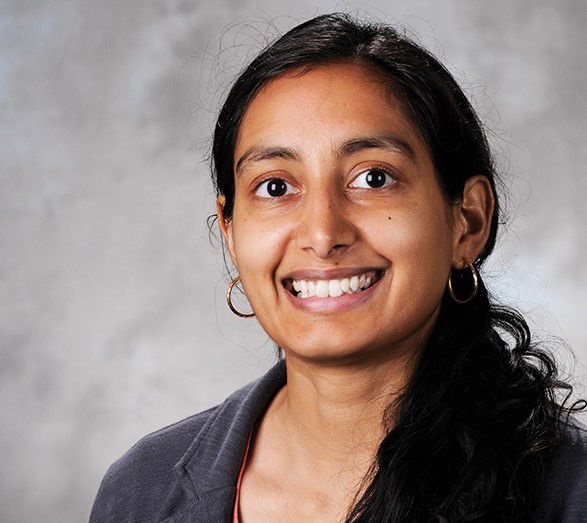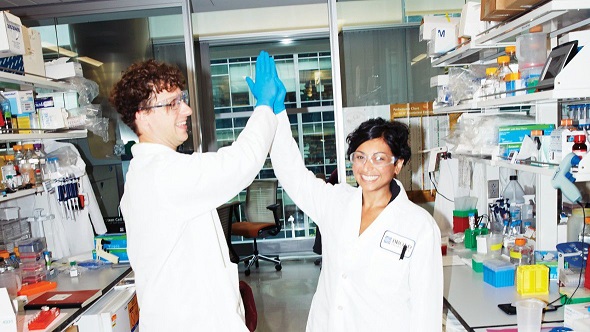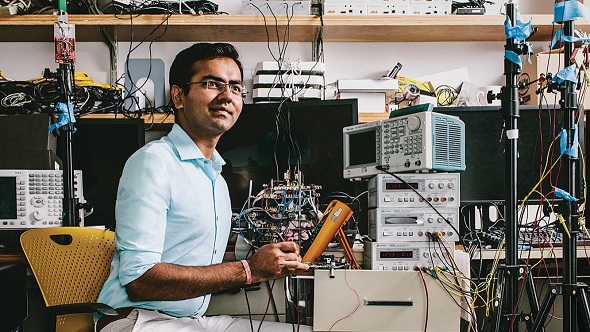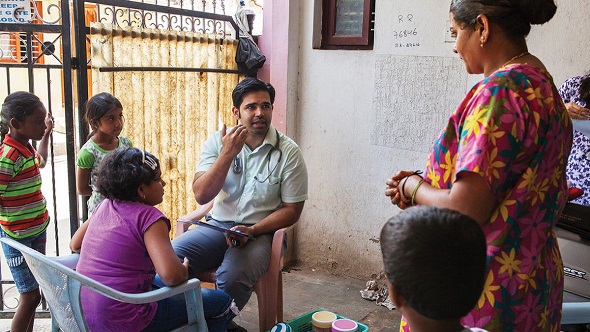Contribute
| MIT Announces 2016 ‘35 Innovators Under 35’ |
Press Release
09/14/2016
Maithilee Kunda, Sonia Vallabh, Dinesh Bharadia and Jagdish Chaturvedi were named among MIT Technology Review’s recently-released list of “35 Innovators Under 35†for 2016.
In the 16th annual release of the MIT Review-created and curated list, Maithilee Kunda, Sonia Vallabh, Dinesh Bharadia and Jagdish Chaturvedi were among the Indian American innovators honored. Additionally, Samay Kohli of India and Bangladeshi-American Ehsan Hoque were also named to the list.
The list recognizes disrupters and dreamers, according to the Technology Review.
“They’re inquisitive and persistent, inspired and inspiring,†it said. “No matter whether they’re pursuing medical breakthroughs, refashioning energy technologies, making computers more useful or engineering cooler electronic devices — and regardless of whether they are heading startups, working in big companies or doing research in academic labs — they all are poised to be leaders in their fields.â€
The list is broken up into five categories: inventors, entrepreneurs, visionaries, humanitarians and pioneers.
Bharadia was named among the inventors, Kohli in the entrepreneurs’ category, Kunda was among the visionaries, and Chaturvedi, Hoque and Vallabh were listed in the humanitarians’ category. No Indian origin or South Asian was part of the pioneer section.
Kunda, 32, is an assistant professor of computer science and computer engineering in the department of Electrical Engineering and Computer Science at Vanderbilt University. She was previously a research scientist in the School of Interactive Computing at Georgia Tech.
Her work in artificial intelligence, in the area of cognitive systems, looks at how visual thinking contributes to learning and intelligent behavior with a focus on applications for individuals on the autism spectrum, according to her Vanderbilt bio page.
She holds a B.S. in mathematics with computer science from MIT and a doctorate in computer science from Georgia Tech. Kunda currently directs the laboratory for Artificial Intelligence and Visual Analogical Systems.
“I’ve been taking what we learn from people on the autism spectrum who have interesting visual abilities and building that into AI systems," Kunda said in the Technology Review piece. "It’s early, but I expect that they ultimately will be very valuable. If we want to help students learn to solve difficult problems, then we ought to have several AI tutors that can show students different ways of solving the same problem.
"If we want to help doctors find patterns of disease outbreaks, then we ought to have multiple AI analysts that can sift through the data using different styles of pattern finding,†she added.
Vallabh, 32, is a prion scientist at the Broad Institute in Cambridge, Mass., where she’s been since May 2015. She also serves as the director of Boston-based Prion Alliance.
The Swarthmore College and Harvard Law School graduate is currently pursuing her doctorate in biological and biomedical sciences at Harvard Medical School.
Vallabh learned after graduating from Harvard Law School that she has a genetic mutation that causes a deadly brain disease.
Today she and her husband work in a lab at the Broad Institute of MIT and Harvard and have published research showing a possible pathway to a treatment.
Vallabh explained her story at an event on precision medicine with President Barack Obama in February.
“We all carry around thousands of typos in our DNA, most of which don’t matter much to our health, but my typo is an unusually clear-cut case. It’s a single change in a particular gene that causes fatal genetic prion disease, where patients can live 50 healthy years but then suddenly fall into deep dementia and die within a year. And there’s no treatment, at least, not yet," she said at the event.
In 2010, her 51-year-old mother began to "waste away" and it was learned from her autopsy that Vallabh had a 50 percent chance of inheriting the genetic mutation that killed her.
“We decided right away I’d get tested. We wanted to know what we were up against."
A geneticist later confirmed Vallabh had the same change and "waged a campaign to educate ourselves, taking night classes, attending conferences and eventually taking new jobs in research labs."
The couple now devote their lives to developing therapeutics for the disease.
"We are going to do everything we can, hand in hand with creative allies from every sector, to build this bridge as we walk across it and develop a treatment that could save my life, and the lives of many others.â€
Bharadia, 28, a clandestine at the MIT Computer Science and Artificial Intelligence Laboratory, invented a telecommunications technology that everyone said would never work, the Review noted. He found a way to simultaneously transmit and receive data on the same frequency.
Because the signal from broadcasting a radio transmission can be 100 billion times louder than the receiving one, it was always assumed that outgoing signals would invariably drown out incoming ones. That’s why radios typically send and receive on different frequencies or rapidly alternate between transmitting and receiving.
“Even textbooks kind of assumed it was impossible,†Bharadia said in the MIT piece.
Bharadia developed hardware and software that selectively cancel the far louder outgoing transmission so that a radio can decipher the incoming message. The creation of the first full-duplex radio, which eventually could be incorporated into cell phones, should effectively double available wireless bandwidth by simply using it twice, it added.
Bharadia took a leave of absence from his doctorate studies at Stanford so he could commercialize the radio through the startup Kumu Networks. Germany-based Deutsche Telekom began testing it in 2015, but since Bharadia’s prototype circuit board is too large to fit in a phone, it will be up to other engineers to miniaturize it, MIT noted.
Bharadia is a graduate of IIT Kanpur and earned his master's from Stanford, both in electrical engineering.
“I invented a low-cost ear, nose, and throat imaging device. So I call myself the first ENTrepreneur!" the 30-year-old Chaturvedi, a self-proclaimed amateur standup comedian, said in the MIT report.
He credits performing on stage to destressing and honing his skills.
“Those skills helped me invent Entraview, which has helped 200,000 patients. As a trainee doctor I saw many farmers with advanced throat cancer. I discovered that expensive imaging systems were only available in major cities, so rural doctors relied on outdated mirrors and headlamps. I asked my boss why no one had tried attaching endoscopes to small off-the-shelf cameras," he said.
The boss said, ‘Why don’t you?’ and then he went for it.
“Entraview was a big learning curve for me. I worked with a design firm but got too involved trying to create a one-size-fits-all device. I’d nearly exhausted my funds when my boss said, ‘Go learn the right way to do this.’"
Chaturvedi added, “The Stanford-India Biodesign program teaches Indian doctors and engineers how to invent. Their process showed me where I’d gone wrong and gave me the connections to arrange a pitch with Medtronic. We simplified and focused on ears. Not the original goal, but the path of least resistance to market, and now the platform can evolve."
Since then, he has contributed to 18 medical-device inventions. Chaturvedi is now clinical lead at a med-tech incubator, InnAccel, where he helps multiple startups while still practicing medicine.
“India imports 75 percent of its medical tech. We have great inventors, but most make the same mistakes because they don’t get the innovation process. The first step is finding the right team.â€
Kohli, a 30-year-old founder and chief executive officer of Gurgaon, India-based company GreyOrange, is eyeing overseas expansion.
According to the MIT piece, Kohli and his robotics firm have helped the e-commerce boom in India by developing warehouse automation technologies.
GreyOrange sells swarms of “Butler†robots, which store products and bring shelves to human workers, and “Sorters,†which automatically scan and sort packages of any size or shape.
The company boasts 92 percent of India’s warehouse automation market, a sector that Kohli thinks “can become humongous,†according to MIT.
The company plans to expand into the Middle East and China in 2016 and within two years, Kohli expects to be exporting warehouse robots to Europe.
He hopes to have a first-mover advantage over other robotics startups chasing the same opportunity, one that became even larger after Amazon bought the warehouse automation company Kiva Systems in 2012 and brought its technology in house rather than selling it to Amazon’s e-commerce rivals, MIT said.
Kohli and his cofounder Akash Gupta launched the company in 2011, after developing, while in college, what they believe to be India’s first humanoid robot. Seeing China’s e-commerce boom, they spotted “an industry ripe for disruption,†says Kohli.
Kohli earned his bachelor's and master's degrees at the Birla Institute of Technology and Science.
Hoque, 34, is a researcher at the University of Rochester. He has created two computer systems that train people to excel in social settings.
One program has a virtual businesswoman that can recognize your expressions and statements so she can nod, smile and prompt you with further questions as you chat with her. At the end of the conversation she’ll give you feedback about your interpersonal performance, including your body language, intonation and eye contact.
Hoque also designed a pared-down mobile version, free for anyone with Internet access to use, MIT added in its piece.
There’s no animated character, instead, it records video and sends you a write-up about your social skills, noting the speed of your speech, the pitch and loudness of your voice, the intensity of your smiles and whether you overused certain words.
All of Hoque’s research comes back to his brother, a teenager with Down syndrome.
Hoque is his brother’s primary caretaker and has seen how difficult social interactions of any kind can be for him, especially in school, MIT noted.
Hoque hopes his tools will be useful to all kinds of people—individuals with Asperger’s, customer service representatives, nervous students with looming class presentations, or even just someone gearing up for a date or an interview, it added.
Hoque is a graduate of Penn State University (B.S.), the University of Memphis (M.S.) and MIT (doctorate).
You may also access this article through our web-site http://www.lokvani.com/



